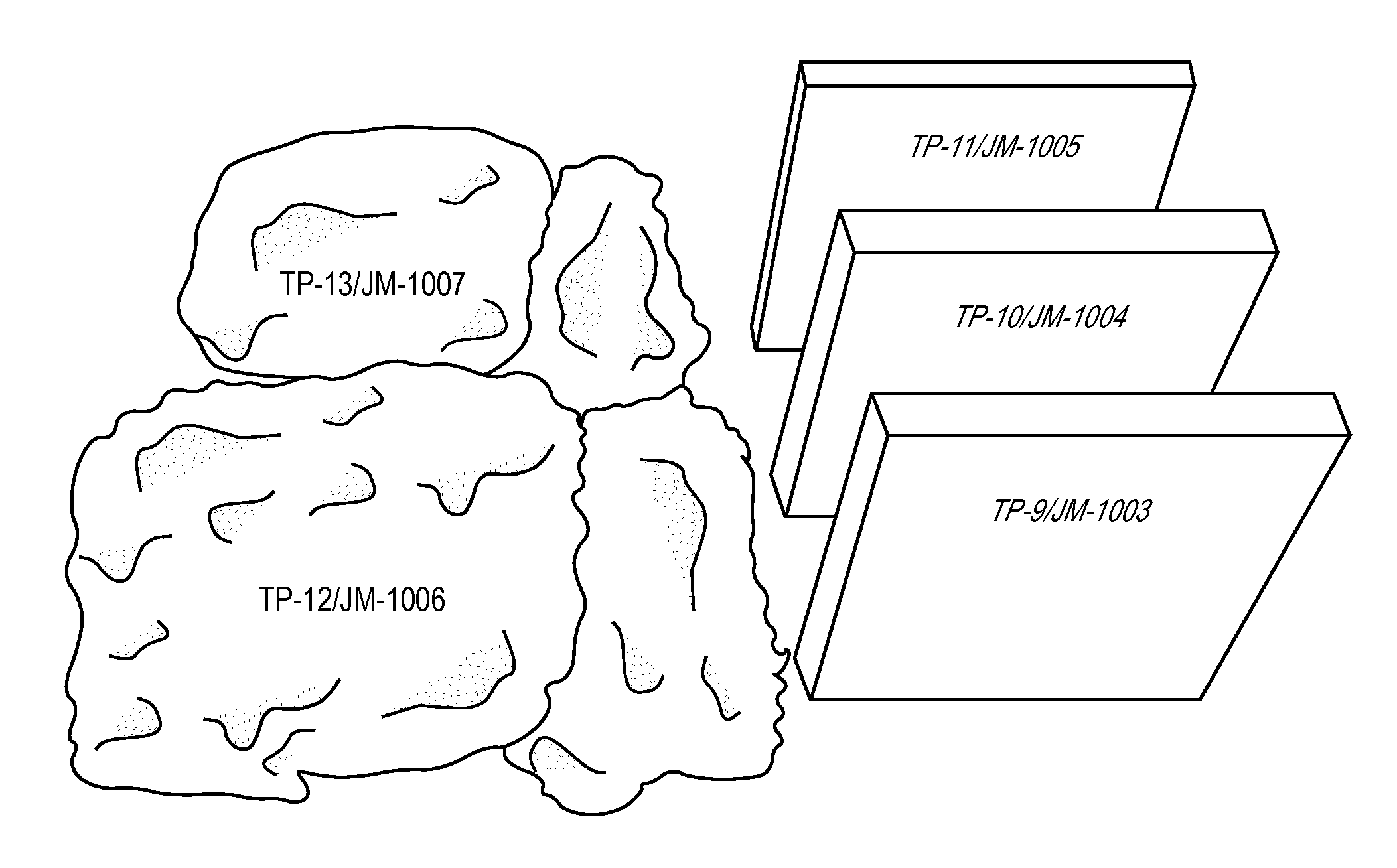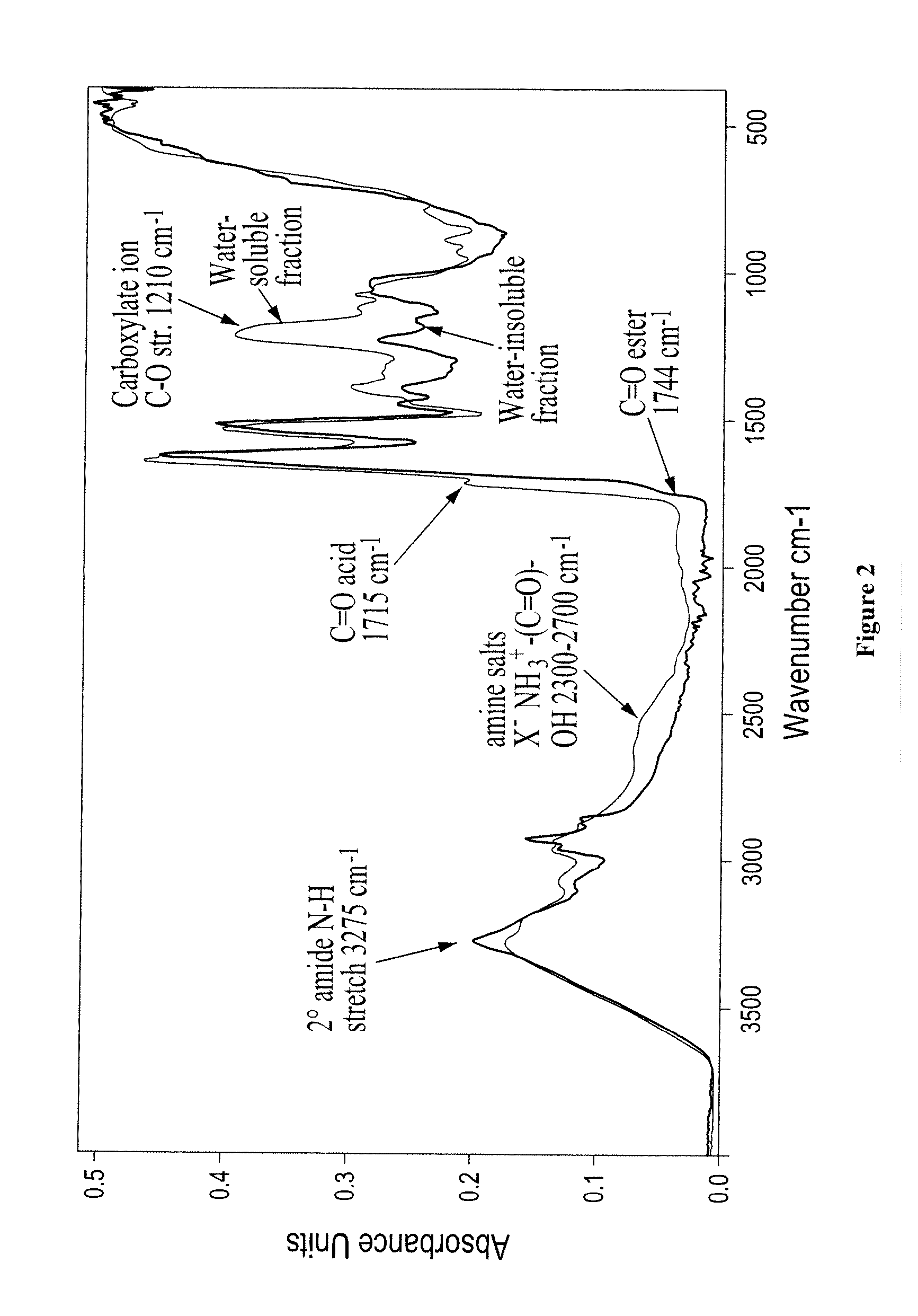Protein-containing adhesives, and manufacture and use thereof
a technology of adhesives and proteins, applied in the field of protein adhesives, can solve the problems of failure to produce a formulation with sufficient cohesive strength to produce particle board composites, and achieve the effect of increasing water resistance and optimizing the performance properties of particle boards
- Summary
- Abstract
- Description
- Claims
- Application Information
AI Technical Summary
Benefits of technology
Problems solved by technology
Method used
Image
Examples
example 1
Isolation of Polypeptide Compositions
[0274]Exemplary procedures for isolating and characterizing the water-insoluble polypeptide composition, water-soluble polypeptide composition, or a mixture thereof are described below.
Procedure A: Preparation of Water-Insoluble Polypeptide Composition and Preparation of Water-Soluble Polypeptide Composition.
[0275]Everlase digested protein from castor (experimental sample lot 5-90) was obtained from Prof. S. Braun at the Laboratory of the Department of Applied Biology at the Hebrew University of Jerusalem, Israel. Digested castor can be prepared as follows: castor meal protein is suspended in water at the ratio of about 1:10 w / w. Calcium chloride is added to an effective concentration of about 10 mM, and the pH of the suspension adjusted to pH 9 by the addition of 10 N NaOH. The reaction is then heated to 55° C. while stirring. Next, Everlase 16L Type EX® (NOVOZYMES') is added at the ratio of 20 g per kg of castor meal protein, and the mixture is...
example 2
Characterization of Polypeptide Compositions by Mass Spectrometry
[0302]This Example describes characterization of the various protein samples via MALDI Mass Spectrometry using an Ultraflex III instrument from Bruker.
[0303]The instrument was set in positive mode, in order to detect positive ions generated during the ionization process. The voltage applied to accelerate the ion into the TOF analyzer was set at 25 KV. The analysis was carried out by using the instrument in reflection mode which improves the resolution. Solid samples were dissolved in DMSO at a concentration of 10 mg / mL. Water-soluble supernatant fractions which were solvated in water.
[0304]Each sample solution was mixed with a matrix solution (for analytical purposes). The matrix was an inert compound of low molecular weight which absorbs at the same wavelength of the laser, Nd:YAG 355 nm. The matrices used were: α-CHCA, alpha-cyano-4-hydroxycinnamic acid, dissolved in a solution of ACN / H2O (70:30) with 0.1% of TFA at ...
example 3
Characterization of Polypeptide Compositions by Two-Dimensional Proton-Nitrogen NMR Correlation Spectra and Characterization of a Water-Insoluble / Water-Dispersible Polypeptide Fraction
[0310]The water-insoluble and water-soluble protein fractions were prepared as follows. Digested castor (lot 5-83) was suspended in water at the ratio of 1:10 w / w. Calcium chloride was added to the effective concentration of 10 mM, and the pH of the suspension was adjusted to pH 9 by the addition of 10 N NaOH. The reaction was heated to 55° C. while stirring. Everlase 16L Type EX® (NOVOZYMES') then was added at the ratio of 10 g per kg of castor meal protein, and the mixture was stirred at the same temperature for 4 hours. The resulting mixture then was brought to a pH 3.5 with citric acid and was spray-dried to yield a tan powder. Then, the water-insoluble and water-soluble protein fractions were harvested as described in Example 1 (Procedure A) and were allowed to air-dry at 23° C.
[0311]The dried pow...
PUM
| Property | Measurement | Unit |
|---|---|---|
| Fraction | aaaaa | aaaaa |
| Fraction | aaaaa | aaaaa |
| Fraction | aaaaa | aaaaa |
Abstract
Description
Claims
Application Information
 Login to View More
Login to View More - R&D
- Intellectual Property
- Life Sciences
- Materials
- Tech Scout
- Unparalleled Data Quality
- Higher Quality Content
- 60% Fewer Hallucinations
Browse by: Latest US Patents, China's latest patents, Technical Efficacy Thesaurus, Application Domain, Technology Topic, Popular Technical Reports.
© 2025 PatSnap. All rights reserved.Legal|Privacy policy|Modern Slavery Act Transparency Statement|Sitemap|About US| Contact US: help@patsnap.com



